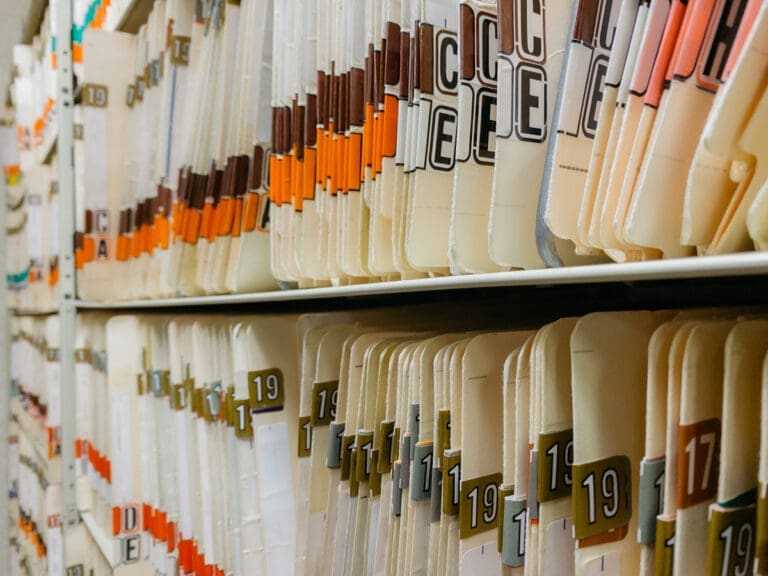Although the world is growing increasingly digital, hard copies still have their place. A scanned version of a historic map just isn’t the same as the real thing, and you never know when you’ll need original copies of financial or legal documents.
When it comes to preserving documents, you need to know what items need climate-controlled storage and why. But first, you should learn more about climate-controlled storage and the benefits it offers.
With Armstrong Archives, you’ll receive the specialized storage you need in the hot, humid Texas climate. Here’s what you can expect.
What Is Climate-Controlled Storage?
Before you choose the type of storage that’s right for your important documents, you probably want to know the answer to this question: What is climate-controlled storage, and how is it different from storing my documents in a standard storage unit?
Standard storage facilities leave your contents vulnerable to damage from fluctuating temperatures and humidity levels. In contrast, climate-controlled storage facilities are designed to create optimal conditions for long-term storage, preserving items like documents, photos, and artworks.
With services like boxing, records management, scanning, and on-site security, Armstrong Archives is well-positioned to meet your document storage needs. The stable temperature and humidity levels in the climate-controlled areas of our facilities mean you can rest easy, knowing your essential documents are protected from all manner of harm.
Why Choose Climate-Controlled Storage?
If you’re just storing documents for a short while, why would you need climate-controlled storage? Even in the short term, you should consider how temperature, humidity, and other environmental factors could affect your critical documents.
Preserving the integrity of documents can be just as important as properly cataloging them for storage. Imagine retrieving a sensitive document and finding out it has become discolored from heat or affected by mold growth, compromising its content and integrity. If pristine preservation is a concern, climate-controlled storage is vital.
What Items Require Climate-Controlled Storage?
When you’re deciding which documents to store in a climate-controlled facility, consider the potential for harm if these items are left to the elements.
Paper is delicate and can deteriorate when exposed to high temperatures, becoming brittle and suffering discoloration and warping. It may also be susceptible to mold and mildew in humid conditions. Climate-controlled storage will combat these dangers and ensure that your documents remain safe and intact.
Now that you know what could happen if important items are stored improperly, it’s time to consider which types of documents need climate-controlled storage. Temperature-controlled facilities are recommended for the following:
Important Documents
Individuals and businesses alike may amass important documents that are difficult to store at residential or commercial locations. When it comes to what items need climate-controlled storage, there are several key categories.
Legal documents, such as deeds and signed contracts, should be stored in perpetuity. These vital records could be important if you need to prove property ownership, transfer assets, or provide original documents for legal proceedings.
It’s always wise to store original financial records for tax purposes. Medical practices and employers may also want to store important records, while individuals might need to preserve medical documents involving claims for reimbursement or compensation.
Blueprints and Architectural Drawings
Whether you’re storing blueprints for patent purposes or saving architectural drawings for posterity, you want to keep them in the best possible condition for an indefinite length of time. A climate-controlled environment is the best option for such items, helping to ensure that they’re preserved in their original form.
Photographs and Historical Records
There’s more to photos and records than mere nostalgia; these items often hold historical significance.
You may have photos and documents related to historical figures, places, or events. They could be linked to the history of a family, business, civic group, or government entity. With temperature- and humidity-controlled storage, you have the best chance to preserve these keepsakes intact for generations to come.
Artworks and Archival Materials
Other materials that need climate-controlled storage include works of art like drawings, paintings, and illuminated manuscripts. Comics, journals, literature, and sheet music are also vulnerable to fluctuating heat and humidity levels.
The unifying feature is that these items have some special value, whether financial or historical. You want to properly care for these items to ensure they hold their value, and a climate-controlled environment is a great option.
Armstrong Archives’ Specialized Services
Few climates are ideal for storing sensitive items, but our Texas climate brings both heat and humidity that can work in tandem to destroy your valuable documents. You need an experienced partner who offers the protective benefits of climate-controlled storage, paired with robust building security and a range of additional services.
Armstrong Archives delivers a targeted approach to document preservation, empowering every client to customize their experience and enjoy peace of mind. Are you looking for the best way to keep your documents safe and in top condition? Contact us now to learn more and to request a quote for services.












